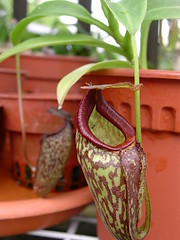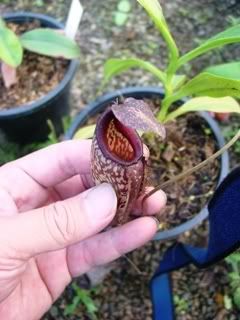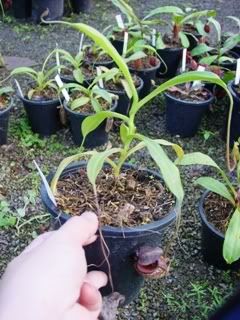|
|
Post by tarence on Nov 13, 2007 8:25:55 GMT 8
the lady is growing quite fast...it`s already into its 3rd & 4th pitcher while the 1st one after it arrived is still holding strong.  my current fav nep.....coz i ain`t got many hybrids laa. |
|
|
|
Post by David on Nov 13, 2007 12:59:18 GMT 8
What a beauty. Can't wait for mine to grow it's pitchers. Mine started to revive after I place it outside my apartment window. I guess the cooler air and stronger sunlight helps. A new pitcher is opening.  How much sunlight do you give this fella Tarence? How about water? |
|
|
|
Post by tarence on Nov 13, 2007 13:20:20 GMT 8
thx David....it gets morning sun from about 8 to 10:30 a.m., unfiltered. Then dappled evening sun hits it from about 4 p.m. onwards.......watered twice a day. I treat it no diff from my other neps, i just talk to it & admire it more. Heheh.
|
|
|
|
Post by sweethalo on Nov 13, 2007 16:37:44 GMT 8
wow! so this one doesn't need aircon?
|
|
|
|
Post by tarence on Nov 13, 2007 17:24:20 GMT 8
nope, it doesn`t.....
|
|
|
|
Post by rainforestguy on Nov 24, 2007 5:32:06 GMT 8
While Lady Pauline grows rapidly somewhat initially, I have found EP's reverse cross of N. maxima x talangensis to be more vigorous especially as the plant approaches upper vining and flowering stages. N. talangensis as the mother clearly shows the weaker side of talangensis for those living in warmer growing conditions.
M
|
|
|
|
Post by isaacgoh on Nov 25, 2007 0:00:22 GMT 8
Hi Mike,
Interesting observation by you. I just learnt something new.
Thanks.
Rgds,
Isaac
|
|
|
|
Post by rainforestguy on Nov 25, 2007 1:29:48 GMT 8
The Lady Pauline since this is from a specific clone, prefers highland conditions almost exclusively. While the reverse cross are seedlings, each will adapt and respond to whatever temperatures are thrown at them.
I have uppers on all my Lady Pauline and max x talangensis, and the max x talangensis are superior in form over the Lady Paulines!
M
|
|
|
|
Post by borneo on Nov 27, 2007 14:34:26 GMT 8
|
|
|
|
Post by rainforestguy on Nov 28, 2007 1:36:37 GMT 8
Again, this plant is a clear example of a plant grown highland not the warm tropics as we experience growing. I have Lady Pauline and trust me, it is not that well adapted for warm growing. For those who might wonder why your plants seems to produce smaller and weaker vines, consider the photos you see of plants grown cool, and then look at your own plants in front of you. Believe me, its not your growing conditions, but rather the less than desirable growing conditions that the particular tc clone is not adapted to. Seed-origin plants adapt better and cope with your actual growing conditions. You will experience these phenomenon over time.
M
|
|
|
|
Post by borneo on Nov 29, 2007 19:01:12 GMT 8
We propagate this hybrid from a TC clone both out of the flask but mostly vegetatively from cuttings. It tolerates warm conditions quite well as I said but of course it's easier to grow in intermediate conditions. It's also highly vigorous.
|
|
|
|
Post by rainforestguy on Nov 30, 2007 10:37:46 GMT 8
Time will expose itself.
Meanwhile, we sit, wait and wait, and wait, and wait and wait.
The improbable is that talangensis x maxima will grow best in cold climates, and somewhat diminish over time (short time) in warmer climates.
M
|
|
|
|
Post by bugbeware on Dec 5, 2007 1:53:28 GMT 8
  Lowland condition not slow grower |
|
|
|
Post by rainforestguy on Dec 5, 2007 13:56:05 GMT 8
I did not say anything about it being a slow grower. it just will have difficulty looking decent in the upper pitcher stage. We will be interested in seeing your plant when the green pitchers are produced.
M
|
|
|
|
Post by tarence on Mar 18, 2008 14:04:08 GMT 8
here`s an update...it`s been so long since i last posted any neps pics... say cheese  group photo  |
|
|
|
Post by hongrui on Mar 18, 2008 14:50:17 GMT 8
looking great, tarence!  |
|